Manitoba Insect & Disease Update
Issue 7: June 29, 2016
Summary
Insects: Alfalfa weevil is still at high levels in some alfalfa fields. Some alfalfa hay fields are being cut early as a result. Pea aphid levels are near or above economic threshold in some pea fields, although levels are sporadic as other fields have quite low levels.
Plant Pathogens: Scouting should be continued for all crop diseases. If a fungicide application is required, a timely fungicide application should be planned.
Pulse Crops
Aphids in Peas
Pea aphid levels are high in some fields of field peas, and there has been some control needed in the Winkler area, and some high populations in the Brandon area. Populations vary a lot from field to field, and in other pea fields aphids are hard to find. It is good to monitor pea fields prior to pods being produced to see what aphid levels are like.
How to monitor: The recommended monitoring technique to make management decisions for aphids in field peas is to count aphids on 5 plant tips at each of 4 well-spaced areas in the field (20 plant tips in total). Additional counts may be needed to make accurate decisions if the aphid levels are near the economic threshold. Make sure plant tips are selected randomly to do counts on, and you are not looking for tips that have aphids on them to do the counts on, otherwise you will not know what the true average aphid levels per tip is. Sweep net sampling can also be used to make management decisions.
Economic threshold: For pea aphids on field peas, if at the beginning of flowering there are on average 2 to 3 aphids per 20 cm of plant tip on average or at least 90 to 120 aphids per 10 sweeps on average, an insecticide application when 50 percent of plants have produced some young pods will be cost effective.
Move well into the field to scout for aphids in peas, and don't just sample around the edge. Within individual fields, pea aphid populations may vary depending on location. Incoming winged aphids are often more abundant in the outer rows or windward edges of crops than nearer the center, or in the lee of sheltering vegetation or fences.
Aphid populations are susceptible to stormy weather, particularly high winds, heavy rain and hail. So levels can potentially decrease after a storm. Some parasitism of pea aphids is also being noted. The aphid "mummy" in figure 2 is an aphid found on some peas in the Carman area, which has been parasitized by a parasitic wasp. These will often look swollen and a bronze colour, although the colour of the parasitized aphid can vary depending on the type of wasp parasitizing it.
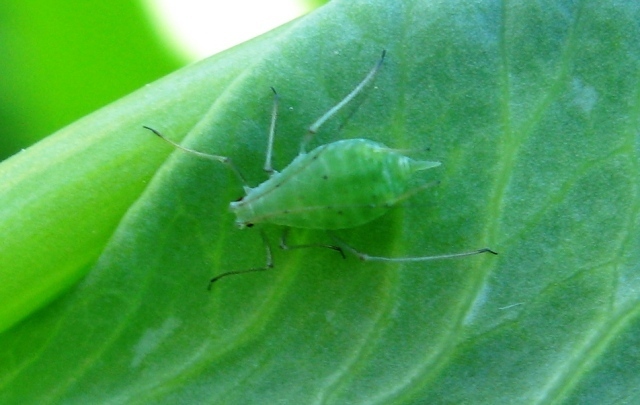
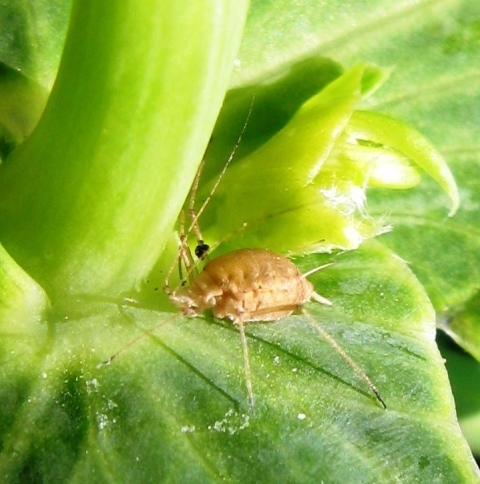
Figure 1. Pea aphid on peas. Figure 2. Parasitized pea aphid.
Soybean diseases
Brown spot and root rots were found in some soybean fields. Brown spot usually starts in the lower canopy and is unlikely to cause significant yield loss.
Insects on Canola
Now that cutworm and flea beetle populations have diminished, there are currently no insect populations observed or reported to be causing economic damage to canola. Traps for adults of bertha armyworm are set up to trap adult moths and determine areas where monitoring for larvae should be given greater importance. Although in most traps the moth counts are still in the low risk range (see insect monitoring data below), in some traps the cumulative moth counts are in the uncertain risk range.
The following question regarding proper use of trap data and management of bertha armyworm has been asked:
Is there any merit to tank mixing an insecticide with a fungicide application for sclerotinia to try to control adults or eggs of bertha armyworm and hence prevent possibly managing larvae later?
The short answer to this is no, for the following reasons:
- Adult emergence and egg laying can be quite prolonged. This reduces the odds of decent kill of adult or eggs.
- Eggs are laid on the underside of leaves, where getting lethal doses to the eggs could have little success.
- There is possible harm to beneficial insects. With some insecticides this includes pollinators, predators and parasitoids, while for the most selective insecticide option harm to beneficial insects is limited to some generalist predators. Regardless there is this consequence that needs to be factored in.
- The purpose of the trap counts and forecasts for bertha armyworm and diamondback moth is to try to help prioritize scouting for larvae, where management thresholds exist. Research data does not exist to back using trap counts as a tool to make management decisions. So in this case using trap data to make management decisions is counter to integrated pest management principals (such as using insecticides only when established thresholds have been exceeded) that such forecasting is trying to enhance.
- Some insecticides can only be applied once to canola. An insecticide application to target the adult or egg stages of bertha armyworm, where success is questionable, may mean the insecticide is not an option later should larvae become a problem. So best to target the stage where successful control is more likely.
- And then there is the economics; applications with questionable results have a higher probability of losing you money instead of adding to your income.
Cereal Crops
Rust update
As reported in a recent cereal rust survey report, crown rust was found in a susceptible variety of oats in South Dakota. Scouting should be continued for rust diseases in cereal crops.
Crown rust spores are orange-yellow in color and are produced on both sides of oat leaf. An optimum temperature range for crown rust development is 20-25˚ C day temperature and 15-20˚ C night temperature with adequate moisture.
Stripe rust produces yellow colored urediniospores which on wind dispersal can start new infection in healthy plants. However, at temperature above 25˚C, urediniospore production slows down or ceases. At advanced stage, stripe rust produces telia on leaf surface which produces teliospores. At higher temperature, leaf rust may continue to produce brown-orange colored urediniospores and spread to healthy plants.
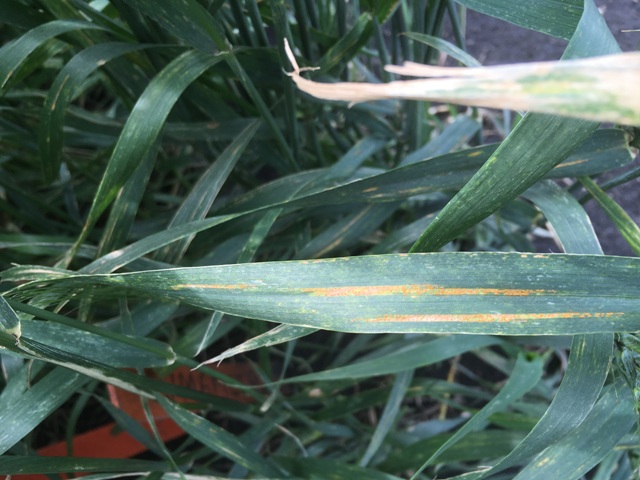
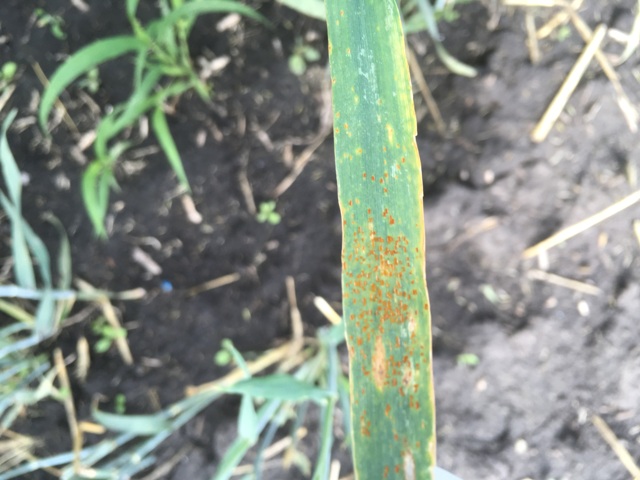
Fig. 3. Stripe rust in wheat Fig. 4. Leaf rust in wheat
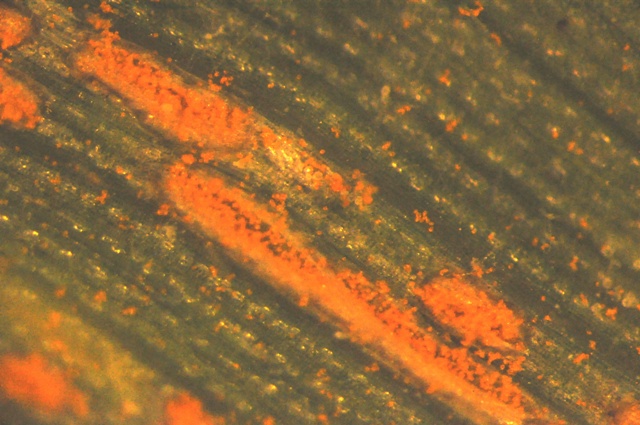
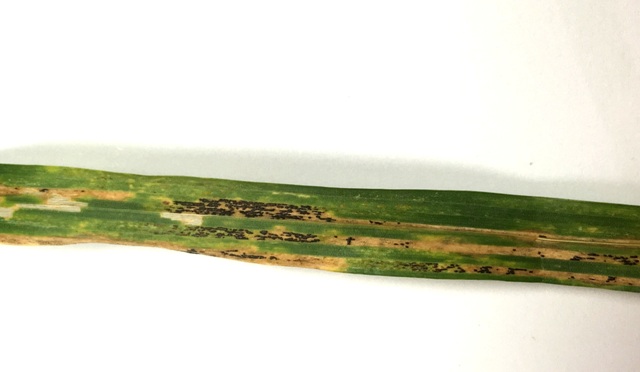
Fig. 5. Urediniospores of stripe rust Fig. 6. Telia of stripe rust.
Other cereal diseases
A few cases of bacterial blight in cereal crops have been reported.
Depending on crop stage and local weather conditions, cereal crops may be at risk of developing Fusarium head blight (FHB) infection. If fungicide application is required, a timely application (at anthesis) should be planned.
Refer to Guide to Field Crop Protection for information on fungicides registered for suppression of FHB.
FHB risk forecast maps are posted daily at FHB report.
FHB risk forecast maps are posted daily at FHB report.
Emergence of wheat Midge
The following map shows the percent of wheat midge that are expected to have emerged, based on models using degree days to calculate percent emergence. We are generally above average for degree day accumulation in Manitoba, and it is likely that wheat midge emergence has started in Manitoba, although in many areas it may only be about 10% of the wheat midge that have emerged (light yellow on the map). Some areas of Central amd Southwest Manitoba may have closer to 50% emergence (darker yellow on the map).
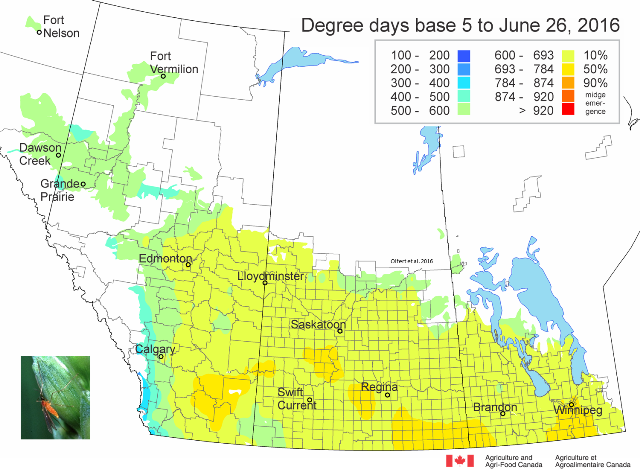
A reminder that wheat that has already produced anthers is no longer susceptible to feeding by wheat midge.
Note: Emergence may be 2–8 days later than expected at sites receiving more than 145 mm rain in May and June.
Sunflower diseases
A few cases of downy mildew in sunflowers have been reported.
Insect (or pathogen) Identification Quiz
Question: What has made the blotches on these pea leaves?
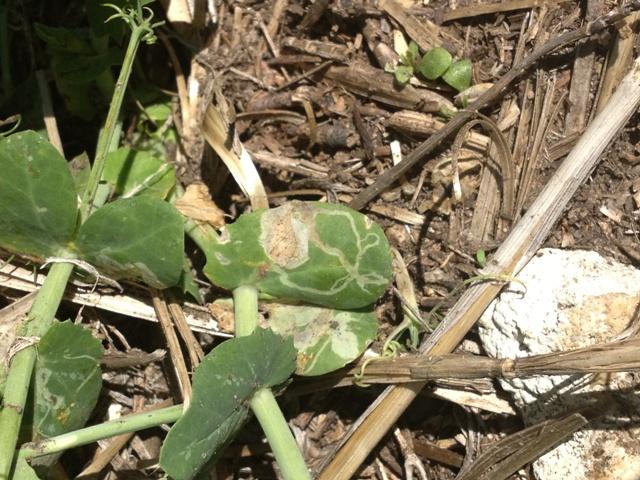
Photo courtesy of Jennifer Anderson - Advantage Coop
Answer: These mines in the pea leaves are caused by leafminers, which are larvae of flies generally in a family of flies known as Agromyzidae. The damage is strictly cosmetic, and should not be economical.
Insect Monitoring Programs
Bertha armyworm: So far cumulative trap counts for bertha armyworm are mainly in the low risk range (less than 300), although a couple a counts in southwest Manitoba are in the uncertain risk range (. Highest counts, as of June 29 are:
| Location | Count |
|---|---|
| Minto | 331, 311 |
| Roblin | 271 |
| Swan Valley | 153 |
| Benito, Lena | 120 |
Diamondback Moth: Trapping of adult diamondback moths is now done for the year. Highest counts were in the northwest, with some moderate counts in the Central and Eastern regions. Scouting for larvae is recommended, particularly in area with higher trap counts. Currently some larvae are being found, but so far not at levels close to the suggested nominal thresholds.
A summary of diamondback moth monitoring in Manitoba, and more detailed interpretation, can be found at:
http://www.gov.mb.ca/agriculture/crops/insects/diamondback-moth-forecast.html Compiled by:
John Gavloski, Entomologist Pratisara Bajracharya, Field Crop Pathologist
Manitoba Agriculture Manitoba Agriculture
Phone: (204) 745-5668 Phone: (204) 750-4248
To report observations on insects or plant pathogens that may be of interest or importance to farmers and agronomists in Manitoba, please send messages to the above contacts.
To be placed on an E-mail list so you will be notified immediately when new Manitoba Insect and Disease Updates are posted, please contact John Gavloski .
